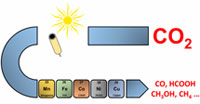Publication
817
ACS Catal., 7 (1), 70-88, 2017
DOI:10.1021/acscatal.6b02181
|
|
|
|
|
|
 |
Electrons, photons, protons and earth abundant metal complexes for molecular catalysis of CO2 reduction
|
|
|
|
Hiroyuki Takeda, Claudio Cometto, Osamu Ishitani, and Marc Robert
Department of Chemistry, Faculty of Science, Tokyo Institute of Technology, 2-12-1, NE-1 O-okayama, Meguro-ku, Tokyo, 152-8550, Japan
Université Paris Diderot, Sorbonne Paris Cité, Laboratoire d’Electrochimie Moléculaire, Unité Mixte de Recherche Université−CNRS no. 7591, Bâtiment Lavoisier, 15 rue Jean de Baïf, 75205 CEDEX 13 Paris, France
Electrochemical and photochemical reduction of CO2, or a smart combination of both, are appealing approaches for the storage of renewable, intermittent energies and may lead to the production of fuels and of value-added chemicals. By using only earth-abundant metal (Cu, Ni, Co, Mn, Fe) complexes, cheap electrodes and/or cheap sacrificial electron donors and visible light sensitizers, systems functioning with molecular catalysts have been recently designed, showing promising results, in particular, for the two-electron reduction of the carbon dioxide. By combining experimental and mechanistic studies, key parameters controlling the catalysis efficiency have been deciphered, opening the way to the design of future, more efficient and durable catalysts, as well as to the development of electrochemical or photoelectrochemical cells, all being key steps for the emergence of applied devices. The most recent advances related to these issues are discussed in this review. |

